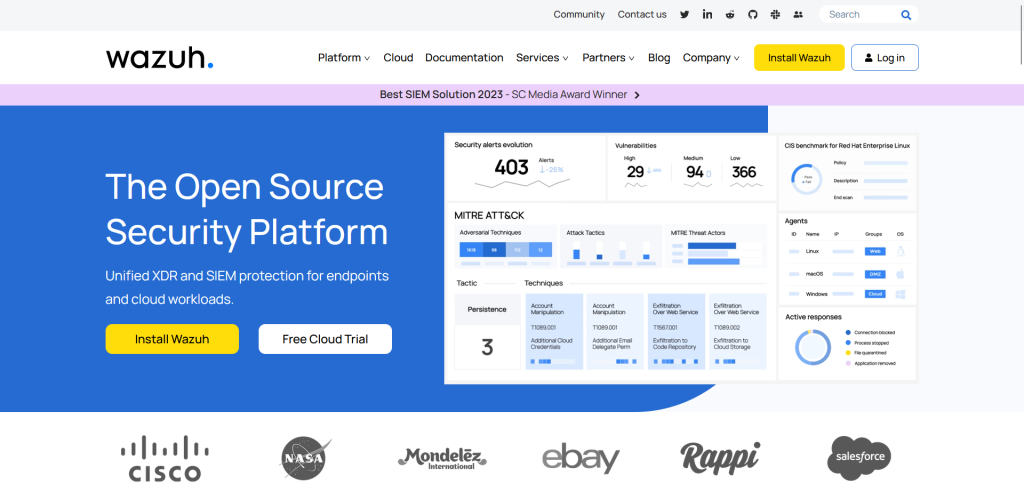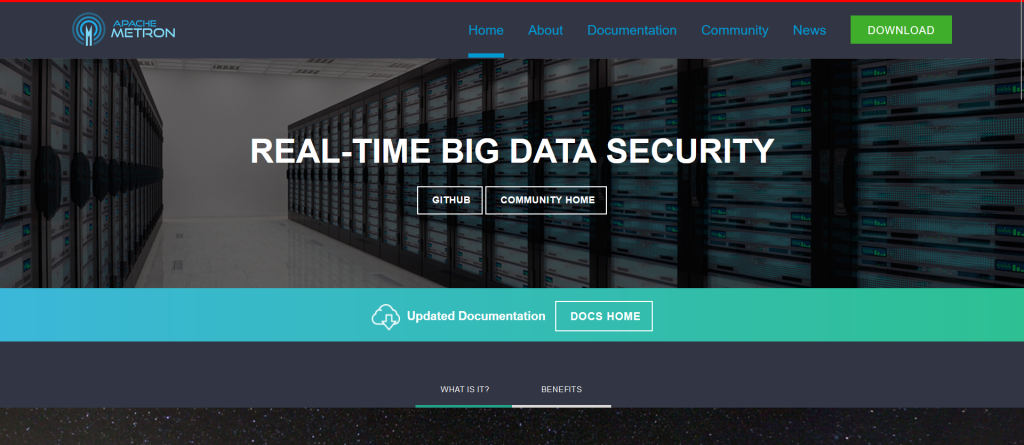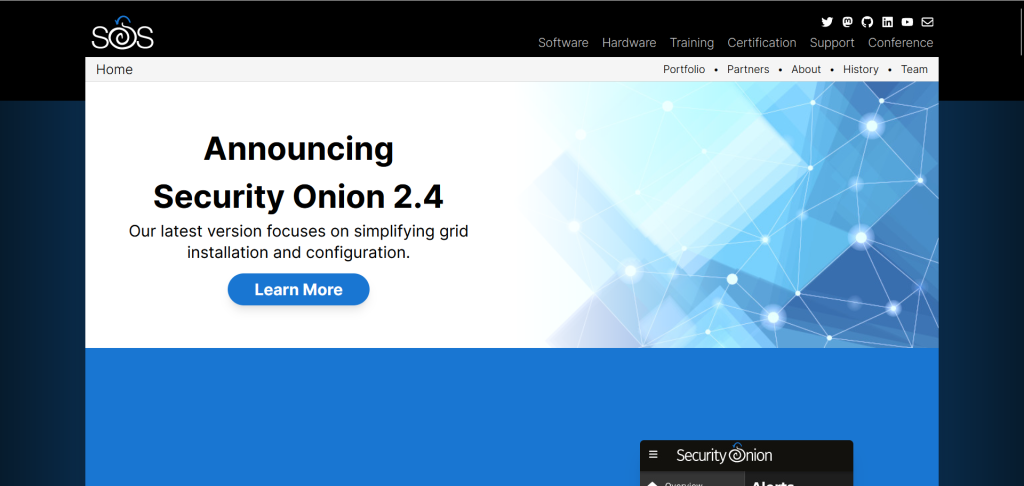Table of Contents:
FAQ
SIEM Capabilities and Applications
Top 8 Open Source SIEM Tools
OSSIM
OSSEC
Wazuh
Apache Metron
SIEMonster
Prelude SIEM
Security Onion
Suricata
FAQ
1.What is SIEM?
A security information and event management (SIEM) system is the foundation of security processes in the modern security operations center (SOC). A SIEM saves security analysts the effort of monitoring many different systems.
SIEM systems integrate with security tools, network monitoring tools, performance monitoring tools, critical servers and endpoints, and other IT systems. It aggregates the data, correlates it, analyzes it to discover anomalous or suspicious activity, and generates alerts when it identifies an activity that might be a security incident.
2. Is Wazuh totally free?
Wazuh is a free and open-source platform for security monitoring that includes tools for analyzing logs, detecting intrusions, and keeping tabs on compliance.
Its fundamental parts are freely usable because it is an open-source solution. No expense is associated with the user’s download, installation, and configuration of Wazuh.
While the program itself doesn’t cost anything, there may be expenses associated with adopting and maintaining it, particularly in a big or complicated context.
If you require external support for setup and configuration, you may incur additional fees for hardware, additional software integrations, or expert services.
3. Is SIEM outdated?
While Security Information and Event Management (SIEM) systems are far from obsolete, their place and capabilities in the ever-changing world of cybersecurity are changing.
Artificial intelligence (AI), machine learning (ML), and user and entity behavior analytics (UEBA) are some of the advanced features that modern SIEM systems have integrated, albeit their original purpose was log aggregation and compliance reporting.
Improved detection and response to complex cyber threats are outcomes of these developments.
Extended Detection and Response (XDR) and other new technologies are on the horizon, but SIEM is still a vital tool for many companies.
SIEM Capabilities and Applications
SIEM solutions offer various capabilities that provide visibility into an entire corporate network of devices and apps. SIEM provides a centralized location for data collection and aggregation, including dashboards that offer insights into overall security and specific threats.
Threat intelligence
SIEM solutions offer insight into known indicators of compromise (IoC) and attacker tactics, techniques, and procedures (TTP). The tool uses several threat intelligence feeds, organizing and analyzing information on current and potential threats.
Threat detection
SIEM tools can detect threats in various locations, including emails, applications, cloud resources, endpoints, and external threat intelligence sources. Most SIEM solutions achieve threat detection by employing user and entity behavior analytics (UEBA). It helps monitor and detect abnormal behaviors indicating a threat, such as compromised accounts and lateral movement.
Alerting and investigation
After detecting a vulnerability, threat, suspicious behavior, or attack, SIEM tools create and send alerts to the relevant personnel for response and mitigation, supporting incident response operations. You can customize SIEM alerts to suit user needs and use managed rules to react almost in real time to critical threats. Some solutions also offer workflow and case management with automatically created investigation instructions.
Compliance and reporting
SIEM solutions support compliance and alert reporting to help organizations simplify compliance reporting. This functionality includes data dashboards that help monitor privileged user access and retain and organize event information.
Top 8 Open Source SIEM Tools
OSSIM

Core Features:
- Precision terrain correction and orthorectification
- Histogram matching and tonal balancing
- GDAL/OGR Integration
Deployment model: on-premise
AlienVault OSSIM is an open-source security solution that provides an intuitive platform for analyzing impending security risks. It provides various tools, including event correlation, vulnerability assessment, behavioral monitoring, and asset discovery.
OSSIM provides a complete SIEM by employing correlation capabilities, native log storage, and various open-source projects, such as FProbe, Nagios, Munin, NFSen/NFDump, OSSEC, OpenVAS, PRADS, Suricata, TCPTrack, and Snort.
To Whom it is advised?
OSSIM (Open Source Security Information Management) is recommended for small to medium-sized corporations, educational institutions, and organizations with restricted resources that want a complete and affordable SIEM solution.
IT professionals, security analysts, and network administrators who need security monitoring, log management, and incident response without commercial SIEM solution prices would love it.
OSSIM integrates open-source security products into a single platform for enterprises who desire an integrated security approach but can’t afford proprietary solutions.
Its community-driven platform and user-friendly interface make it accessible to enterprises with less cybersecurity experience. However, advanced capabilities for experienced users make it a viable security tool for many needs.
OSSEC

Core Features:
- Open Source HIDS
- Multiplatform HIDS
- PCI Compliance
Deployment model: on-premise
Atomic Enterprise OSSEC is a cloud-based solution that offers various security and compliance capabilities. It helps organizations automate security processes in cloud, hybrid, and on-premise environments.
OSSEC is based on an open-source security framework that enables you to monitor and route logs and events to multiple SIEMs.
OSSEC offers intrusion detection, compliance reporting, file integrity monitoring, and policy management. It supports many compliance regulations, including JSIG, HIPAA, GDPR, and PCI DSS. The platform lets you manage rules centrally and sends alerts to notify users about security changes to systems or files.
To Whom it is advised?
Small to medium-sized enterprises, system administrators, and IT professionals seeking a cost-effective and powerful security solution might choose OSSEC, an open-source host-based intrusion detection system.
It targets individuals who need to monitor servers for suspicious activity, ensure system integrity, and comply with security regulations.
OSSEC is ideal for enterprises that need a lightweight, adaptable security technology that can be integrated into their infrastructure.
Its adaptability and ability to run on several operating systems make it suited for larger companies wishing to expand their security architecture.
The platform’s active community and detailed documentation make it accessible to cybersecurity novices and experts. Numerous sectors and environments choose OSSEC for its dependable and scalable intrusion detection technology.
Wazuh

Core Features:
- Active XDR protection
- from modern threats
- Regulatory Compliance
- Posture Management
Deployment model: on-premise
Wazuh is an open-source platform with threat prevention, detection, and response capabilities. You can use Wazuh to protect workloads across on-premises, containerized, cloud-based, and virtualized environments.
Wazuh employs various mechanisms, including an endpoint security agent that monitors systems. It uses a management server to collect and analyze data collected by these agents.
Additionally, Wazuh is fully integrated with the Elastic Stack, providing a search engine and data visualization tool that enables navigating through security alerts.
To Whom it is advised?
Wazuh, an open-source security monitoring tool, is recommended for SMBs, large companies, and security professionals.
It’s ideal for companies seeking a comprehensive intrusion detection, compliance monitoring, and log analysis solution without the exorbitant expenses of commercial security systems.
Wazuh serves financial, healthcare, education, and government businesses that need sophisticated security and compliance management.
IT teams and security experts of all sizes who need a flexible and comprehensive security platform like its scalability and versatility.
Wazuh’s active community support and thorough documentation make it accessible to more than just major organizations with professional security teams.
Apache Metron

Core Features:
- Interactive Visualization and alerting
Multi-vendor Sensor Support
- Leverages the Apache Big Data Ecosystem
Deployment model: on-premise
Apache Metron is a security framework for ingesting, processing, and storing diverse security data feeds at scale. It aims to enable organizations to detect and rapidly respond to cyber anomalies.
Here are the key capabilities of this framework:
- Security data lake or vault—the framework provides cost-effective, long-term storage for enriched telemetry data. You can leverage this data for feature engineering and discovery analytics, as well as search and query operational analytics.
- Pluggable framework—Metron provides a rich set of parsers for common security data sources, including pcap, bro, netflow, snort, Sourcefire, and fireeye. It also offers a pluggable framework. You can use it to add new custom parsers for various new data sources and add new enrichment services for context. It lets you use pluggable extensions for threat intel feeds and customize your security dashboards.
- Security application—the framework offers standard SIEM capabilities, including alerting, agents to ingest data sources, and threat intel framework. It also includes packet replay utilities and hunting services.
- Threat intelligence—the framework provides next-generation defense techniques that employ anomaly detection and machine learning algorithms in real-time while events stream in.
To Whom it is advised?
Apache Metron is recommended for large corporations and security operations centers (SOCs) that need scalable and comprehensive security monitoring and analysis.
IT experts and security analysts with big data platform knowledge and network security and anomaly detection skills should consider it.
Metron provides real-time security analytics using open-source big data technologies and is ideal for organizations that need to handle and analyse massive amounts of data to detect sophisticated cyber threats.
Apache Metron is mostly used by large IT departments that prioritize data-driven security analytics due to its complexity and management.
SIEMonster

Core Features:
- Ingesting million+ Events Per Second (EPS)
- Custom branding / white labeling
- Auto scalability both horizontally and vertically
Deployment model: on-premise
SIEMonster is an enterprise-grade SIEM tool that combines several open-source solutions into one centralized platform to provide real-time threat intelligence. Here are key features of SIEMonster
- Human-based behavior—the tool can integrate with behavioral analysis tools to ensure recorded threats are true and minimize false positives.
- Threat intelligence—the tool offers real-time threat intelligence, including open source or commercial feeds, to stop attacks as they occur.
- Deep learning—the tool employs machine learning for analysis and to automatically kill attacks.
To Whom it is advised?
SIEMonster is recommended for SMBs, startups, and companies with restricted budgets that need a powerful and affordable SIEM solution.
It attracts enterprises who wish to use open-source security monitoring and threat detection without the exorbitant expense of commercial SIEM products.
IT and security teams looking for a flexible and scalable SIEM solution that can grow with their firm should choose SIEMonster.
For companies that must comply with industry norms, the platform delivers log management, threat intelligence, and compliance reporting.
Its user-friendly design and community assistance make it accessible to enterprises with modest cybersecurity expertise, but it can also handle advanced users.
Prelude SIEM

Core Features:
- Intrusion Detection Message Exchange Format
- quickly analyze the cause of an alert
- publish various formats
Deployment model: on-premise
Prelude SIEM extends Prelude OSS to include an ergonomic interface and various security capabilities. It lets you continuously monitor your security posture for possible intrusion attempts and quickly analyze the cause of an alert.
You can employ Prelude SIEM to correlate, search, investigate, and compare information to identify subtle threats and maintain the integrity of evidence. The tool lets you design and publish various formats of functional or technical reports.
To whom it is advised?
For comprehensive and scalable security information and event management, enterprises and IT professionals should use Prelude SIEM. It is ideal for medium to large corporations, government agencies, and complex network infrastructure organizations that need advanced threat detection, analysis, and compliance management.
The powerful platform for real-time analysis of network hardware and application security alerts makes Prelude SIEM ideal for security analysts, network administrators, and cybersecurity teams.
Its broad logging, monitoring, and reporting capabilities make it excellent for enterprises complying with various regulatory obligations.
Security Onion

Core Features:
Network Visibility
- Security Onion Desktop
- Static Analysis (PCAP and EVTX Import)
Deployment model: on-premise
Security Onion is a Linux distribution for enterprise security monitoring (ESM) and intrusion detection. It offers network-based and host-based intrusion detection systems (IDS) and full packet capture (FPC), supporting various enterprise security monitoring and threat-hunting responsibilities.
Here are key features:
- Support for network-based intrusion detection systems (NIDS)—Security Onion collects network events from various tools, such as Suricata and Zeek, to provide complete coverage of the enterprise network.
- Support for host-based intrusion detection system (HIDS)—Security Onion supports host-based event collection agents, such as Wazuh, Osquery, and Beats.
- Static analysis (PCAP Import)—you can use Security Onion to import PCAP files for quick static analysis and case studies.
To whom it is advised?
IT workers, security analysts, and network administrators who manage network security and threat detection should use Security Onion. It is ideal for medium to big organizations, educational institutions, and government bodies that need a powerful, integrated security monitoring platform.
Security Onion is appropriate for diverse security environments since it includes intrusion detection, network security monitoring, and log management tools.
Since it needs knowledge of network protocols, security analysis, and incident response, its users are usually network security experts. The platform also helps enterprises perform network security analysis and digital forensics without pricey commercial software.
Suricata

Core Features:
- Automatic Protocol Detection
- Industry Standard Outputs
- NSM: More than an IDS
Deployment model: on-premise
Suricata is an open-source engine for high-performance network IDS, IPS, and network security monitoring.
It is owned by the Open Information Security Foundation (OISF), a non-profit organization. Suricata can store TLS certificates, log HTTP request logs, extract files from flows, and store them on disks.
Suricata uses automatic protocol detection for protocols like HTTP on all ports to apply the proper detection.
It maintains integrations in JSON and YAML to support databases like Splunk and Elasticsearch and supports multithreading natively.
To whom it is advised?
Network administrators, security professionals, and IT teams responsible for network security promote Suricata, an open-source network threat detection application.
Small to large businesses, government entities, and educational institutions can use it. Suricata specializes in real-time IDS, inline IPS, and network security monitoring (NSM), making it a versatile tool for network security improvement.
The program is useful for analyzing large amounts of network traffic, identifying sophisticated threats, and responding quickly to security problems. Suricata’s community-driven strategy appeals to environments that require collaboration and threat intelligence exchange.
Conclusion
In this article, I explained the basics of SIEM platforms and presented 10 open-source SIEM solutions to get you started on your security data journey.
While many of these SIEMs are not as fully featured as commercial solutions, they provide more than enough functionality for small-to-medium organizations building their first SOC.
-1.webp?w=1068&resize=1068,0&ssl=1)


.webp?w=218&resize=218,150&ssl=1)

%20(1).webp?w=218&resize=218,150&ssl=1)